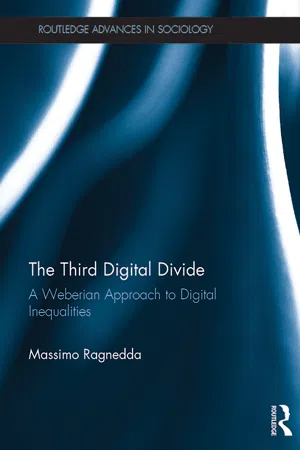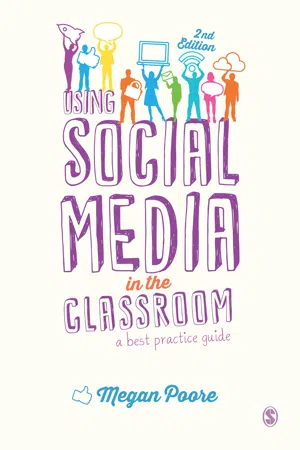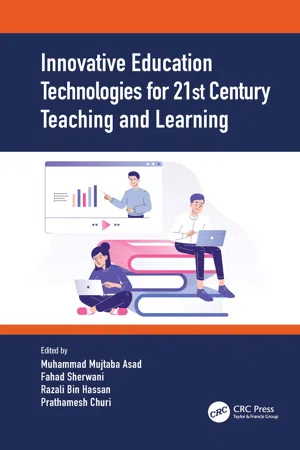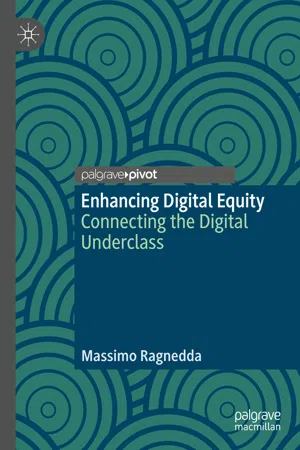Digital Divide
The digital divide refers to the gap between those who have access to digital technologies and those who do not. This divide can be based on factors such as income, education, geography, and age. It encompasses disparities in internet access, computer ownership, and digital literacy, and has implications for social and economic equality.
8 Key excerpts on "Digital Divide"
- eBook - ePub
- Steven L. Danver(Author)
- 2016(Publication Date)
- SAGE Publications, Inc(Publisher)
...Rolando Avila Rolando Avila Rolando, Avila Digital Divide Digital Divide 317 321 Digital Divide In simple terms, Digital Divide has been defined as the gap between groups of people who have access to technology and/or information, know-how to use it, and benefit from its use and groups of people who do not have this access, knowledge, and ability to benefit from it. In more complex terms, the Digital Divide may be defined in the following manner: Different people, at any specific points in time, have possessed varying degrees of technology and information skills, and their place in the Digital Divide has depended on where they have fallen within the continuum of skills and knowledge. Furthermore, since the realm of technology and information has been constantly evolving, even those with certain skills run the risk of falling behind unless they are able to make technology and information an authentic part of their daily lives. This entry discusses the multiple types of gaps in access to digital technology and the reasons for those gaps. It then discusses statistical trends involved in the Digital Divide and the impact of the Digital Divide. Historically, factors associated with the gap between the have and have-nots in the digital arena have included income, race, gender, age, and location. For many years, the Digital Divide has been a global problem, and various entities have strived to address it through measures such as increasing the number of computers and Internet connections in schools. In an increasingly digital world, access to and mastery of technology and information skills have become increasingly vital. Ultimately, a lack of technology literacy may affect an individual’s ability to function competitively in an increasingly technological society. Unequal Access Income levels have been one of the major determinants of the levels of access to technology...
- eBook - ePub
- Kylie A. Peppler(Author)
- 2017(Publication Date)
- SAGE Publications, Inc(Publisher)
...Mariela J. Rivas Mariela J. Rivas Rivas, Mark Warschauer Mark Warschauer Warschauer, Mark Digital Divide Digital Divide 213 216 Digital Divide The term Digital Divide refers to the inequality of access to computers and the Internet. Today, this term has been expanded beyond the simple binary to include not only physical access but also the ability to use technology meaningfully. Inequalities in physical access and meaningful use of technology exist among people of different income levels, education, community type, age, and race/ethnicity, which may affect educational outcomes. This entry reviews the use of the term over time, presents statistics on access both in the United States and throughout the world, reviews the Digital Divide in education, and discusses initiatives aimed at reducing this divide. History and Early Initiatives The term Digital Divide has evolved over time. In the 1990s, the Internet started to grow in popularity. During this time, journalists, officials, and activists began using the term to describe the growing concern over the consequences of unequal access to information and communication technology. In the mid-1990s, the Clinton administration used the term often, especially Larry Irving, director of the National Telecommunications and Information Administration. This organization documented access to computers by demographic groups in the United States and has been publishing detailed reports since 1995. The awareness of the gap in Internet access in the United States was followed by policy initiatives to address it. These initiatives included the E-rate program, which provided funding to increase Internet connectivity in schools and libraries. In later years, inclusion programs were aimed at bringing broadband connectivity and technology education to underserved populations. Some initiatives focused on providing low-cost devices, such as India’s Simputer, One Laptop per Child, and Brazil’s People’s Computer...
- eBook - ePub
The Third Digital Divide
A Weberian Approach to Digital Inequalities
- Massimo Ragnedda(Author)
- 2017(Publication Date)
- Routledge(Publisher)
...I shall start by attempting to define the Digital Divide taking into account its complexity. Second, I shall discuss the rise of this issue as a social and public concern, going beyond questions of technological infrastructure and economic issues. I shall end this section by highlighting some of the difficulties and challenges that those wishing to analyse this phenomenon from a multidimensional perspective might encounter. Attempting to define the Digital Divide The Digital Divide first gained prominence as a policy issue thanks to reports released by the US Department of Commerce’s National Telecommunications and Information Administration (NTIA). The first report was released in July 1995, entitled, ‘Falling through the Net: A Survey of the “Have Nots” in Rural and Urban America’; a second was released in July 1998, entitled ‘Falling through the Net II: New Data on the Digital Divide’, and a third report in July 1999, entitled, ‘Falling through the Net: Defining the Digital Divide’. Based on these reports, the issue came to be included on academic and political agendas in the US. They refer to the socio-economic gap between communities with access to computers and the Internet and those without, in one of the first attempts to define the Digital Divide. At this early stage of its development, the concept of the Digital Divide tended to be seen as the gap between those with access to new technologies and those without (Hoffman and Novak, 1998; Katz and Aspden, 1997). Thus, in its most simplistic terms, the Digital Divide was defined as a form of inequality in access to new ICTs, and in particular to the Internet (Besser, 2004). This approach, taking for granted the availability of a telephone line, distinguishes between those who have a personal computer and a modem, and then can access the Internet, and those who, not having this technology, remain cut off from its possibilities...
- eBook - ePub
Using Social Media in the Classroom
A Best Practice Guide
- Megan Poore(Author)
- 2015(Publication Date)
- SAGE Publications Ltd(Publisher)
...Chapter 5 The Digital Divide and Digital Participation Overview This chapter explores the development of the idea of the ‘Digital Divide’ and describes current understandings of how the Digital Divide is affecting our lives, that is, that the divide today is often described more in terms of access to networks and knowledge than it is simply in terms of access to hardware. The chapter then goes on to discuss the differences between a ‘participation’ approach and an ‘inclusion’ approach to bridging this divide, meaning that, although social inclusion agendas may have a noble end in mind, they nevertheless cannot help but present those ‘being included’ as passive objects of policy rather than as active participants in a society. A participation approach is preferred because its starting point assumes not that students need to have things done to them (that is, to ‘be included’), but that young people have something valuable and worthwhile to contribute to begin with. The chapter demonstrates the importance of building the digital capital of all students. The Digital Divide What is the Digital Divide? The term ‘Digital Divide’ has been around since the mid-1990s and is generally understood to describe the gap between those who have access to digital technology and those who do not (Green and Hannon, 2007, pp. 59–60). In the early days of home computing this problem of ‘access’ was explained almost solely in terms of access to the hardware systems that supported it – meaning, access to PCs, printers, laptops, the internet, servers, email, and the like. Today, however, the nature of the divide has shifted. No longer is simple access to equipment as big a problem as previously: hardware has become cheaper, allowing more and more people to have a computer or similar device, and even if you don’t have a desktop computer at home, you are likely to have a computer in your pocket (namely, your smartphone), or you might own a netbook or laptop...
- Muhammad Mujtaba Asad, Fahad Sherwani, Razali Bin Hassan, Prathamesh Churi, Muhammad Mujtaba Asad, Fahad Sherwani, Razali Bin Hassan, Prathamesh Churi(Authors)
- 2021(Publication Date)
- CRC Press(Publisher)
...These disparities are more prevalent in low-income countries. For example, in sub-Saharan Africa, 89% of learners do not have access to household computers, and 82% lack internet access. Furthermore, while mobile phones can enable access to information, around 56 million learners live in locations not served by mobile networks, almost half in sub-Saharan Africa (the same report informed). The economic and digital disparities point to questions of inequalities that are historically developed in many parts of the world. It is acknowledged that “while efforts to provide connectivity to all must be multiplied, we now know that continued teaching and learning cannot be limited to online means. To lessen already existing inequalities, we must also support other alternatives including the use of community radio and television broadcasts, and creativity in all ways of learning. These are solutions we are addressing with our Global Coalition partners”, stated Audrey Azoulay, UNESCO Director-General. 12.4 Digital Divide Many countries are facing technological ‘gaps’ due to internet connectivity, digital learning, and cultural/ethnic barriers. The issue of the Digital Divide is a complex one, but often gets described in terms of a single factor, typically as an issue of access and connectivity, resulting in a distorted picture of the issue. The issue of the digital gap is complex, involving spatial stratification of social class and race, and it affects both urban and rural areas. According to Scheerder et al. (2017), the ‘digital gap’ has been a concern for social scientists since the introduction of the internet. In this respect, in the literature there are three degrees of the Digital Divide...
- eBook - ePub
- Mathias Klang, Andrew Murray, Mathias Klang, Andrew Murray(Authors)
- 2016(Publication Date)
- Routledge-Cavendish(Publisher)
...Instead, the Digital Divide can be seen as a temporary phenomenon that reflects a period of institutional mismatch commonly associated with the diffusion of innovations. 6 Over time, disparities in access between, and within, countries will be overcome as digital technologies and their related benefits trickle down throughout societies. This has led some to argue that the Digital Divide is not a crisis as such, and that no major policy interventions are required to ensure the achievement of more equitable participation in the knowledge-based economy. 7 For others, however, national and international disparities in the diffusion of information and communication technologies (ICTs), and especially access to the Internet and the Web, are a source of great consternation. The essence of this apprehension was aptly summarised in the United Nations’ 1999 Human Development Report: The network society is creating parallel communications systems: one for those with income, education and – literally – connections, giving plentiful information at low cost and high speed; the other for those without connections, blocked by high barriers of time, cost and uncertainty and dependent upon outdated information. 8 This view is linked to a broader discourse emphasising the potential social, economic and political benefits to be reaped through the implementation of ICTs. According to enthusiasts, increasing Internet penetration rates and overcoming access-related obstacles should be high on international and national policy agendas because digital technologies are a sine qua non for reducing barriers to trade, enhancing access to information, and expanding social networks. 9 For developed countries, the key issue is seen to reside in ensuring that access to the Internet diffuses in an equitable manner across population segments...
- eBook - ePub
Enhancing Digital Equity
Connecting the Digital Underclass
- Massimo Ragnedda(Author)
- 2020(Publication Date)
- Palgrave Macmillan(Publisher)
...The unequal access to and use of ICTs further deepens social inequalities since those who are already sitting in privileged positions are also those who tend to maximize their use of ICTs, while socially disadvantaged groups tend not to use digital technologies to improve or consolidate their position in society. The Digital Divide, commonly defined as the uneven access and use of digital technologies, is referred to in this book as the “traditional form of digital inequalities”. The Digital Divide is a well-known concept studied and analysed since the second half of the 1990s, when it was first used by a series of newspaper articles in the United States (Gunkel 2003 : 501) and then by the National Telecommunications and Information Administration in the United States (NTIA 1995). It is, therefore, conceived as “traditional” since this concept and phenomenon is part of our terminology and policymakers’ agenda for almost three decades now. More specifically, this concept is often seen in a binary term (Mehra et al. 2004 ; Riggins and Dewan 2005), as the gap in accessing and using ICTs between individuals who have resources (material and immaterial) to access the digital realm and those who are excluded from it. However, this is an outdated approach that suggests a one-dimensional gap mostly based on the possession of technologies used to access the Internet. Framing the Digital Divide as a matter of technological adoption means to reduce it to the simple difference between those who have the device and a connection to the Internet, and those who are excluded from its possibilities. This approach is today known as the first level of Digital Divide (Attewell 2001). This simplistic approach to study the uneven distribution of Internet access (Eastin et al. 2015) has characterized the initial stage of its development (Hoffman and Novak 1998 ; Katz and Aspden 1997)...
- eBook - ePub
- Jan van Dijk(Author)
- 2020(Publication Date)
- Polity(Publisher)
...1 What is the Digital Divide? Introduction: the concept of the Digital Divide In the year 2020 both the concept of and the research into the Digital Divide will be twenty-five years old. In 1995 the term ‘Digital Divide’ was first used in a number of newspapers in the United States. It was backed by data in the report Falling through the Net, published by the National Telecommunications and Information Administration, which talked about ‘haves and have nots’ (NTIA 1995). Soon the concept spread to Europe and the rest of the world, and by the millennium both the idea and the problematic of the Digital Divide were firmly established on the societal and scholarly agenda. But what does the concept actually mean? It has produced so many definitions, controversies and misunderstandings that several people were in favour of discarding it after a few years (Compaine 2001; Gunkel 2003). The most common definition runs as follows: a division between people who have access and use of digital media and those who do not. The term ‘ access ’ was emphasized in the first years of discourse, though later the word ‘ use ’ was highlighted. A common synonym for digital media is the general term ‘information and communication technology’. Access can refer to its devices, connections or applications. The first device to be accessed was a stand-alone computer or a PC, to be followed by a series of digital media, both mobile (mobile phones, laptops, tablets and smartphones) and digitized analogue media (television, radio, cameras and game devices). Connections mentioned were the Internet, mobile telephony and digital broadcasting, with either narrowor broadcasting capacities...







